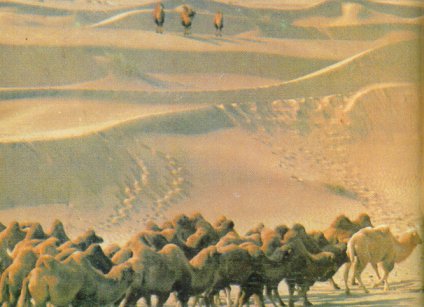Contents
49. Other Translators in the Han Dynasty,
the Period of Three Kingdoms and the Jin Dynasty

49. Other Translators in the Han Dynasty,
the Period of Three Kingdoms and the Jin Dynasty
The following are the famous translators during the Han Dynasty (25-220
A.D.), the Period of Three Kingdoms (220-280 A.D.) and the Jin Dynasty
(280-317 A.D.):
49.1 Kashyapamtanga
[攝摩騰]
- ~25 A.D.
- came from India
- regarded as the first translator for Buddhist sutras in China
- translated 5 sutras, but only 1 extant -- "Sutra of Forty-two
Chapters" [四十二章經]
49.2 Dharmaraksha
[竺法蘭]
- ~25 A.D.
- came from India to China and worked with Kashyapamatanga in
the translation of sutras.
49.3 An
Shih-kao [安世高]
- ~170 A.D.
- It was custom in China to take the name of one's birthplace
as a surname. "An" [安] was actually
not the surname of Shih-kao [世高].
It simply meant that Shih-kao [世高]
came from the country called An-hsi [安息國].
- a prince of Parthia retreated into religion.
- went to China in the Han Dynasty; translated 35 Buddhist scriptures
in 41 fascicles in 20 plus years.
- 20 of them are still extant and most of them are Hinayana
Buddhist texts, such as
49.4 Lokakshema
[支婁迦讖/支讖]
- 147-185 A.D.
- born in Kushan [月支國].
- went to China in the Han Dynasty; translated 12 scriptures
in 27 fascicles in 40 years.
- 9 scriptures in 20 fascicles are still extant and most of
them are Mahayana Buddhist texts such as
- Ashtasahasrika Prajnaparamita Sutra i.e. Perfection of
Wisdom Sutra in Eight Thousand Lines, [般若八千頌]
- 10 fascicles in 179 A.D.
- Pratyutapnna Buddha Sammukhavasthita Samadhi Sutra [般舟三眛經]
- 3 fascicles
49.5 Chu
Shih-hsing [朱士行]
- ~200 A.D.
- went to Khotan and requested the King for the original text
of Mahayana sutras.
- translated the sutras in 291 A.D.
49.6 Fa-shi
[曇柯迦羅/法時]
- came from Central India to China in the Period of Three Kingdoms.
- proficient in both Hinayana and Mahayana, also Vinaya
- translated works included
- the translation of Vinaya to commence the monastic rules and
precepts of Sangha in China.
49.7 Samghavarman
[僧鎧]
- came from Samarkand or Soghdiana [康居國]
to China in the Period of Three Kingdoms.
- India monk believed to be of Tibetan descent.
- translation works included
- Larger Sukhavativyuha, i.e. The Sutra of Infinite Life
[無量壽經] - 2 fascicles, in
252 A.D.
49.8 Tan-ti
[曇諦]
- came from An-Shih [安息國] to
China during the Period of Three Kingdoms
- translated mainly the Vinaya.




